Ok I have only tried 1 of these drinks. Um I felt a combination of Bliss and Blind Rage. I didn't know whether I should run the streets naked or Beat my wife. I'm just sayin. Don't say that u havnt been warned
How Four Loko Sanitized Its Social Media
BY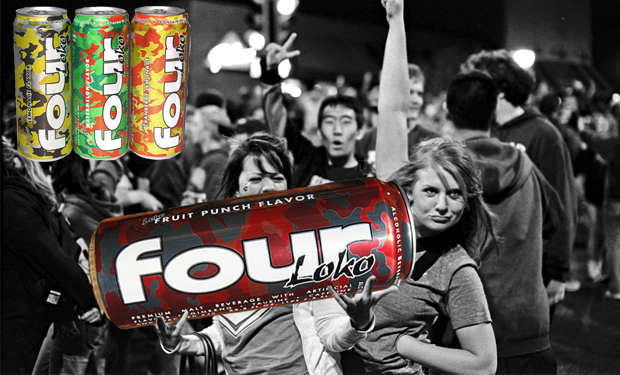
For those who haven't drunk it or seen the breathless news reports, Four Loko is a 23.5 ounce, 12% alcohol-by-volume malt beverage with 135-milligrams of caffeine. It costs $2.50 and is widely known as "blackout in a can." Several colleges have banned the drink and many more are warning students of its consequences.
Now the government is getting involved. The Food and Drug Administration is reviewing whether such concoctions are safe. Senator Chuck Schumer has urged the FTC to investigate whether the colorful cans are intended to attract under-age drinkers. And the drink's maker, Phusion Projects, has come under fire from news outlets such as the New York Times to CBS, which labeled Four Loko "liquid cocaine."
Others might call it a good time.
The drink is the latest in a long line of fads bolstered in popularity by their obvious dangers. Ironically, the more the FDA, FTC, and Chuck Schumer object to its existence, the more popular it is likely to become among millennials and on college campuses. The founders of Four Loko and Phusion Projects--three Ohio State University grads Jaisen Freeman, Jeff Wright, and Chris Hunter--have made an art of pushing their drinks--and their consumers--to the legal limits.
"Our drink isn't an energy drink--it's a caffeinated alcoholic beverage," says Chris Hunter, who spoke with a lawyer's defensiveness. "It's important that we frame it that way because that's the category it's in, and I stress that because some of the scrutiny is about misrepresentations of our brand. We've never called it an energy drink."
To hear Hunter tell it, the drink is no more controversial than any other beverage on the market. He points out that Budweiser is also available in a 24 ounce can; that Bud Light Lime comes in brighter packaging; that certain craft beers have as much as 21% alcohol by volume; that it contains only as much caffeine as a single Starbucks' coffee; that Four Loko has less alcohol than most wines and far less than hard liquor; that it has seven clear labels of its ingredients and content, including a first-of-its-kind "We ID" badge; and that at $2.50, it's "either the most expensive or near the most expensive" of similar-size malt beverages.
Clearly, Phusion Projects has been preparing its defense--not to mention sanitizing its image. Though Hunter says the company has never called its products energy drinks, in a 2006 distributor promotion, Hunter himself said Four "is the ideal drink for social, young adults looking for a great-tasting energy boost." And that was when the drink had half as much alcohol.
In the last week, Phusion Projects quietly altered its company profile. "In 2005, three college friends from The Ohio State University noticed the growing popularity of mixing alcoholic and energy drinks, like Red Bull and vodka, and decided to create a beverage company of their own," the profile originally read. That has been gingerly edited down to: "In 2005, three college friends from The Ohio State University had the entrepreneurial idea to start their own company."
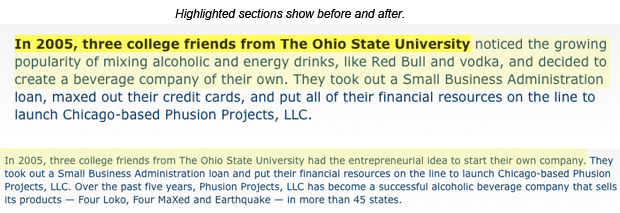
Social media is another element Phusion Projects has tried to distance itself from. On YouTube, Four Loko music videos are incredibly popular--one by Gwop Gang has racked up around 1 million views. On Facebook, Four Loko group pages have tens of thousands of fans. But none of it is official, says the company.
"We don't get involved in social media," says Hunter. "We don't have a company-sponsored Facebook or MySpace or YouTube or Twitter. A lot of other companies in the alcohol industry do, but we wanted to be completely above the line as far as marketing our product responsibly. The stuff out there has happened on its own."
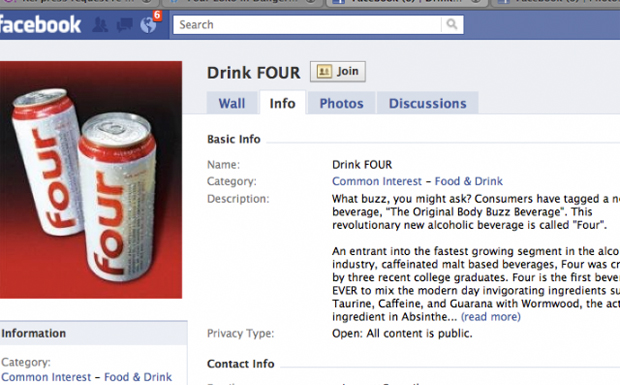
However, as BrandChannel discovered, Four Loko has in no way been divorced from social media. Phusion says its Facebook page (now removed, but pictured) was not "company-sponsored." Instead, it was created by interns. A now-removed section of the company's website called "Four Shots" (below) asked users to "show us your happy-face" by uploading photos with the company's drinks. Albums included college parties ("Northwestern Dillo Day"), while the page also included a game called "Four Play" and a blog called "Four Ever." Again, according to a company statement, these highly professional site features were created by interns.
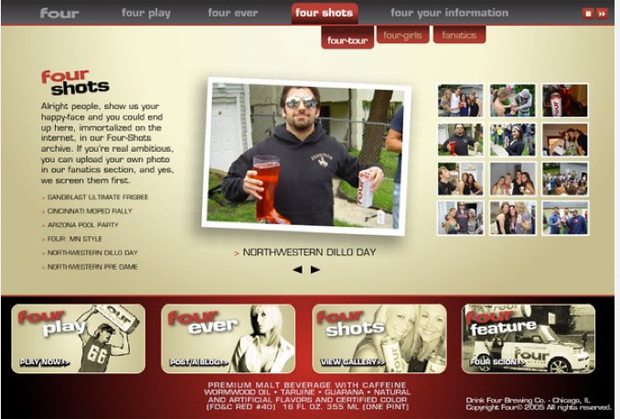
When Hunter objected to me calling Four Loko an energy drink, I pointed out that I had read the language directly from Phusion Projects' website. Silence followed. I read him parts of the phrasing from the now-changed company profile ("three college friends from The Ohio State University noticed the growing popularity of mixing alcoholic and energy drinks, like Red Bull and vodka, and decided to create a beverage company of their own").
"Okay, no worries," he answered.
I then pointed out that the language is now different on the page.
"No worries," he said again.
So it's not an energy drink?
"No, this is a caffeinated alcoholic beverage."
Phusion's products--which have seen triple digit sales growth, according to Hunter--have become popular by pushing the legal limits. Four Loko isn't an energy drink--it's a caffeinated beverage. (What's the difference?) Four Loko is less alcoholic than other products. Four Loko is more expensive than other products. Four Loko is less bright than other products. Four Loko is this, Four Loko is that: one explanation after the next for why the beverage is not dangerous.
At one point, Hunter told me that, "as an interesting side-note, the label for alcohol content on our can is the largest that the federal government will allow." He meant this as another example of how the company was marketing its product responsibly. But isn't this exactly how it's also marketing Four Loko irresponsibly? When a beverage company is magnifying its proof to the max, isn't that just screaming for customers to take notice? The can fairly screams: We're 12%! Is that a precaution or a seduction? "We go above and beyond, as far as how our product is labeled and marketed," Hunter says. Indeed.
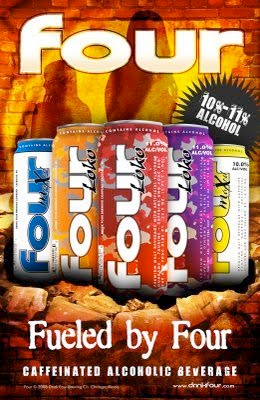
When I asked Hunter about a recent incident at Washington State where nine college students were hospitalized after drinking Four Loko, he said the company was being "singled out," and ticked off a list of justifications, as if he were again in front of a Senate committee:
"The police report showed there was supposedly illegal drugs at the party. That was mentioned about 14 times in the police report. There were multiple mentions of hard liquor, but there were only a few, maybe 2 to 3, mentions of Four Loko. It's really unfair to say our drink was the cause of this. As far as our company goes, we realize we are going to have to ramp up our efforts on consumer education because that's the most important thing to correct these misunderstandings about our product. So to educate consumers to drink responsibly, to not abuse or misuse alcohol, is very important and going to be the focus for our company."
But how can a company that makes and markets a drink that is nearly the equivalent of two Red Bulls and a six-pack of beer focus on educating the consumer not to abuse alcohol? Is it even possible to drink Four Loko responsibly?
"I mean, that depends on who you are," Hunter says. "Everyone is different as far as size, weight, how and how frequently they consume alcohol. There are plenty of people who take the can and pour it over ice and split it with people, and there are probably people who drink it by themselves."
And then black out.
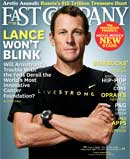
 Digg
Digg StumbleUpon
StumbleUpon Facebook
Facebook Twitter
Twitter Buzz Up!
Buzz Up!
No comments:
Post a Comment